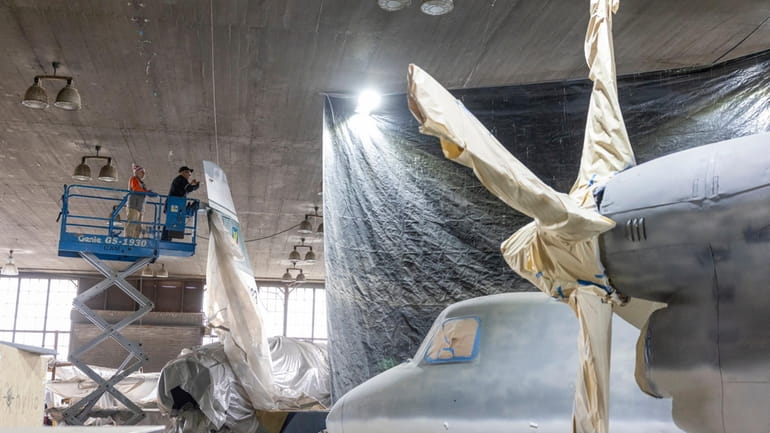Volunteers lend a needed hand at Cradle of Aviation Museum

Having climbed the A-frame ladder, Bob Hoeffner works on the distinctive radome of a Northrop Grumman E-2C Hawkeye. Nearby, Jim Votra and Joe Napodano maneuver an aerial work platform alongside a Vietnam War-era Republic F-105 Thunderchief — to repair the damaged tail.
The three are among a group of volunteers — most, retirees from the aviation industry — who donate their time at the Cradle of Aviation Museum in Garden City. Some serve as docents and museum guides. Others take tickets and give tours to visitors, including a large number of schoolchildren.
Hoeffner, Votra, Napodano and about two dozen others are behind-the-scenes workers who restore, repair, prepare and maintain aircraft and museum exhibits in an old Mitchel Field aircraft hangar known as Hangar 5.
“We rarely, if ever, get anything that doesn’t need work,” said Cradle of Aviation Museum curator Josh Stoff, who oversees the sometimes chaotic, sometimes balletic movements going on amid a host of hangar-bound restoration projects.
WHAT TO KNOW
- A group of volunteers restore vintage aircraft or help out in other ways at the Cradle of Aviation Museum in Garden City.
- Late last month, the museum rolled out a U.S. Navy Grumman F-14 D Tomcat volunteers have spent the past year restoring.
- The Cradle of Aviation has an inventory of about 75 planes.
“A lot of museums have money and can afford to buy finished products," Stoff said. "Not us … Almost everything we have needs restoration. Some are wood workers, some retired engineers. We’ve got metal workers, machinists, people retired from the industry.
“It’s good for them, a social thing. They love being around airplanes. For us, it’s a chance to use their expertise — and make what’s old new again.”
Rolling out a Tomcat
Late last month, the museum rolled out a U.S. Navy Grumman F-14 D Tomcat these volunteers have spent the past year restoring. Once complete, that jet, one of more than 700 built on Long Island, will go on permanent display at the entrance to the museum grounds.
But that Tomcat is just one of many projects being worked on in Hangar 5.
The twin-engine E-2C Hawkeye, an all-weather, carrier-capable tactical airborne early warning surveillance aircraft, the so-called “eyes” of the U.S. naval fleet, is undergoing prep for painting — the final step in a decadeslong restoration en route to eventual display in a new building the museum will break ground on next spring.
That building, said Cradle of Aviation president Andrew Parton, will provide a new exhibit area for the museum jet collection, as well as much-needed library, archive and classroom space.
Other planes in various stages of restoration in Hangar 5 include the F-14, F-105, and an X-29, the experimental Grumman-built forward sweptwing fighter used as a test aircraft by NASA and the U.S. Air Force. Other aircraft undergoing restoration in the hangar include a vintage propeller-engined crop duster and a Fokker D. VII — the latter, a replica of the then-state-of-the-art biplane fighter used by the Germans in World War I.
The Cradle of Aviation has an inventory of about 75 planes, Stoff said.
About half are owned, the other half are on what amounts to permanent loan from various manufacturers and the U.S. Navy or Air Force. All have some tie to the rich aviation history of Long Island.
The planes are restored for static display, not to flying condition.
There’s a replica of the Spirit of St. Louis monoplane Charles Lindbergh flew from the old grass airstrip at Roosevelt Field to Paris in 1927, becoming the first to fly nonstop across the Atlantic.
There’s an exhibit of the Grumman-built Lunar Module, which first carried astronauts Neil Armstrong and Buzz Aldrin to the surface of the Moon in 1969.
In recent weeks, volunteers test-fit the top wing on the Fokker, which is undergoing a painstaking, period-correct restoration. Unlike the jet-age aircraft on display, the framework of the Fokker’s wings are made of wood and eventually will be covered in hand-stitched fabric.
“It’s a lost art," said Stoff, who's been at the Cradle since its inception in 1980. "When the museum started 40 years ago, a lot of guys knew how to do this."
As curator, Stoff does everything from bartering trades to acquire planes and needed restoration parts to overseeing archiving projects — he's in the midst of digitizing 40,000 Long Island aviation-related photo negatives — to running an errand for a roll of blue painter's tape.
Roots in Stony Brook
Stoff grew up in Stony Brook, got his pilot's license at age 16, and earned his master's degree in museum studies at the University of Toronto. He's written a book on the history of Long Island airfields — and is quick to share that there once were 80 airports on Long Island.
The U.S. acquired Fokker D. VIIs following the defeat of Germany in World War I, Stoff said, many of the planes serving with the then-U.S. Army Air Corps at old Mitchel Field. The museum plans to restore the Fokker — with an original engine and gauges — in U.S. military markings.
In a back shop at the Cradle of Aviation, known as the model shop, volunteers are also hand-building a scale replica of the plane, which will be painted in German camouflage and markings, to go on display next to the full-sized replica of the real thing.
Those model makers include Howie Applegate, 91, of Westbury, and Bill DiNoia, 71, of Levittown, both of whom previously built aerodynamic wind tunnel test models and displays for Grumman.
Another model builder, Bill Leonhardt, 76, of East Patchogue, a mechanical engineer retired from a career at Brookhaven National Lab, is using a series of photographs to develop plans to build a scale replica of a 1909 monoplane that once flew out of the airfield complex that surrounded Mitchel Field.
Called a Walden, it was designed and built by Dr. Henry W. Walden, a dentist from Mineola.
“The purpose of the museum is to illustrate the aviation history of Long Island,” Leonhardt said. “And so if we have the actual plane, it’s so much better to show you the actual plane. But, if we don’t have the plane, this is the next-best thing — building a model of it.”
Passionate volunteers
The museum volunteers clearly are passionate about what they do.
Alan Cagan, 81, is a retired recording engineer from Freeport. He and Bryan Weckmann, 62, of Hicksville, a retired FDNY firefighter who said he was at the World Trade Center on Sept. 11, 2001, are members of the so-called “Wrecking Crew” — a group of volunteers who do everything from building displays for the museum to making repairs and creating replica parts from scratch.
“We turn straw into gold,” Cagan said. “That’s Rumpelstiltskin.”
It was Cagan and another volunteer who dug a 1930s wood-framed glider out of a barn at the Rhinebeck Aerodrome in Dutchess County, then trailered it to the museum, where it's undergoing restoration in the wood shop. The glider is one flown in the 1930s out in Montauk, where, Stoff said, enthusiasts towed it airborne behind cars — or simply launched it by jumping off the bluffs.
Volunteer Richard Griffin, 80, of Westbury, Hoeffner, 69, of East Meadow, and Napodano, 70, of Seaford, all worked at Grumman.
Votra, 75, of Franklin Square, grew up in Coney Island, learned to be a plane mechanic at Aviation High School in Queens, and worked for Pan Am at both Kennedy Airport and Newark.
“As long as I can touch an airplane," Votra said, "I’m happy."
“When it comes to visitors," Griffin said, "they don’t see the background of what we do.”
Retired machinist Gabriel Vaca, 76, of Farmingdale, became a volunteer about seven years ago — after his daughter visited the museum with his grandson.
She saw the museum’s Fairchild Republic A-10 Warthog ground attack aircraft on display — and told the museum staff her dad worked on the model.
“Their first reaction was disbelief,” Vaca said. “Next was to tell her, ‘Bring him on down.’ ”
Vaca grew up in Quito, Ecuador, and served in the Ecuadorian Air Force. He later moved to Long Island, studied at Nassau Community College, got a job at Fairchild, then worked for aircraft parts manufacturer EDO before opening his own shop, D.V. Machine Industries Corp., in Farmingdale. He was a subcontractor for Grumman, Fairchild, Boeing and the U.S. Navy. On his phone he proudly keeps a copy of a citation he received from then-Nassau County Executive Laura Curran.
“I made fittings for the hydraulics on the E-2C,” Vaca said, pointing to the restoration underway in Hangar 5. “I enjoy coming over here to help with anything I can.”
Said Stoff of the volunteers: "The bottom line is we couldn’t survive without them because we couldn’t afford to pay them for what they do … We give them direction, decide how a plane is going to be painted or how an exhibit is going to be put on display in the museum. But they do the work."
Man who drove car off cliff due in court ... Fire rips through Amityville home ... Trump on trial ... Lego camp
Man who drove car off cliff due in court ... Fire rips through Amityville home ... Trump on trial ... Lego camp

